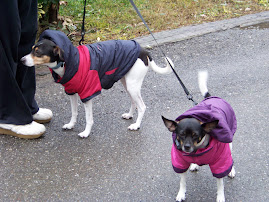
My wife and I own two Rat Terriers - Zoe (4yrs) & Jasper (3yrs), and we take them to the beach every weekend to play with other dogs. Today we met Cisco (Rat Terrier/Chihuahua Mix - above) and Bean (Chihuahua). The were accompanied by the great owners - Pete and Mary Alice.
Our dogs (Zoe & Jasper) meet a lot of playmates whether on the beach, at the dog park, or down the street, which assists with any dog socialization barriers that may exist. While on the beach Pete and I got to talking about a previous weight problem with his dog Cisco (above pic) and how he rose to the challenge.
Our dogs (Zoe & Jasper) meet a lot of playmates whether on the beach, at the dog park, or down the street, which assists with any dog socialization barriers that may exist. While on the beach Pete and I got to talking about a previous weight problem with his dog Cisco (above pic) and how he rose to the challenge.
Simply by cutting back on Cisco's food as well as his consumption rate (food intake frequency), Cisco was able to shed dogie pounds rather quickly. Cisco was crossing the 20lb mark when Pete put his foot down in the name of Cisco's health. Cisco is now well below 20lbs and as healthy as can be according to Pete. Pete did reveal a little secret about his success which was small amounts of fresh beef to speed up his dogie metabolism.
But Cisco wasn't the only pup that wa soaking up the warm weather today on the beach. No no. We also met Bean (aka Beany-Baby), a resuce Chihuahua that has been part of Pete an Mary Alice's family for only one month. Beany, Cisco, Zoe and Jasper, were in dogie heaven today playing on that beach and we counldn't be happy. I want to thank Pete and Mary Alice for their perrmission and their company today. Happy trails dog lovers.










